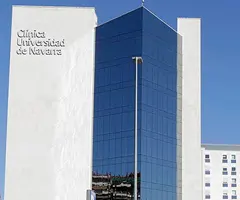Soft tissue sarcoma
"The Clinic has a wealth of experience in the treatment of bone sarcomas with preservation of the extremity. We have a survival rate of around 70% and a limb preservation rate of over 90%".
DR. ALEJANDRO GALLEGO
COORDINATOR. SARCOMAS AREA

What is soft tissue sarcoma?
Soft-tissue sarcomas in pediatric age comprise a group of malignant diseases originating in primitive mesenchymal tissue and which account for 7% of all malignant tumors in children under 20 years of age. It is obvious that they can also develop at any age, although in pediatric ages they have a better prognosis.
Rhabdomyosarcoma is a highly aggressive tumor that is curable in most patients; up to 70% of cases, with proper treatment, remain disease-free for 5 years after diagnosis.
The Clinic is one of the most experienced centers at European level in musculoskeletal tumors and offers one of the highest rates of preservation of the patient's limb worldwide.

A PERSONALIZED MEDICINE
Second Opinion,
peace of mind
Request a second opinion from our professionals with great experience in the diagnosis and treatment of oncological diseases
In 3 days, without leaving home.
Symptoms of soft tissue sarcoma
Soft tissue sarcomas can grow in any location in the body, although they have a preference for the trunk and extremities. The initial clinical picture is rather unremarkable and consists of the development of a solid mass in soft tissue or involving a joint.
It may be mistaken for a traumatic injury or any other cause leading to an area of inflammation.
A poor evolution with the usual anti-inflammatory treatments, together with a torpid, infiltrative and threatening evolution, should lead us to think about the malignant nature of the lesion.
The most common symptoms are:
- Solid mass in soft parts
- Signs of inflammation: warmth, redness, pain
Do you have any of these symptoms?
If you suspect that you have any of the above symptoms,
you should consult a medical specialist for a diagnosis.
Causes of soft tissue sarcoma
Soft tissue sarcomas have been associated with certain genetic and environmental factors.
Patients affected by Li Fraumeni syndrome, which consists of alterations in the p53 gene, have a higher incidence of this sarcoma, bone sarcomas, breast carcinomas, brain tumours and leukaemias than the normal population.
In patients with neurofibromatosis type 1, there is a higher incidence of peripheral neurosarcomas. In familial polyposis adenomatosis there is a higher incidence of desmoid tumours.
In previously irradiated patients there is an increased incidence of soft tissue sarcoma as a secondary tumour and finally chronic Epstein Barr virus infection has been associated with the development of leiomyosarcomas.
Tipos de sarcoma de las partes blandas
Approximately 50% of soft tissue sarcomas are rhabdomyosarcomas (tumours of striated muscle).
The other 50% is made up of a large series of entities known as non-rhabdomyosarcoma soft tissue sarcomas, among which the following are differentiated entities: alveolar soft tissue sarcoma, clear cell sarcoma, fFibrosarcoma, desmoid tumour/aggressive fibromatosis, desmoplastic small round cell tumour, epithelioid sarcoma, myofibromatosis, leiomyosarcoma, liposarcoma, malignant peripheral nerve sheath tumour, synovial sarcoma and Vascular tumours.
How is soft tissue sarcoma diagnosed?
The diagnosis of soft tissue sarcomas is established by biopsy sampling of the lesion and pathological examination of the lesion. Only a pathologist can confirm the diagnosis. We must also carry out a study of the extension of the disease both locally and at a distance.
The size of the primary lesion and its possible resectability are relevant prognostic factors. It is also essential to know whether or not there is metastatic disease when it comes to prognosis or establishing a treatment plan.
Nowadays, it is relatively simple to carry out studies to determine the extent of the disease. After a complete physical examination, an MRI, lung CT and PET scan are performed, as well as analytical tests to determine the state of haematological, renal, hepatic and cardiac function, which are necessary when starting treatment.
Treatment of soft tissue sarcoma
The treatment is not based on a standard rigid and unique protocol for all the cases, but it is based on the combination of surgery, radiotherapy and chemotherapy, adapted to the particularities of each case.
They are not unique options, but each one of them can be applied with diverse modalities that imply a great variability. After the individualized study of each patient, the application of the technique considered to be the most effective and at the most appropriate therapeutic moment will proceed.
The final objective of the surgery is the complete resection of the disease, with clean surgical margins of tumor cells. It should be performed, when this is possible.
If the disease is not resectable at the beginning, we must previously combine chemotherapy and/or radiotherapy to reduce its size, delimit its borders and make it surgically resectable.
Regarding radiotherapy, in the Clinic techniques have been developed for its application, which significantly reduce its toxicity on healthy tissues and especially in the case of young patients, avoiding deformations or subsequent alterations of body growth.
A brachytherapy program has also been developed, with special application in the treatment of soft tissue sarcomas, which ensures local control of the disease, significantly reducing the toxicity of the treatment.
In rhabdomyosarcoma, the role of chemotherapy is fundamental and therefore, it is used as a cytoreductor prior to surgeries or as a complement in the control of possible minimal residual disease, once surgery and radiotherapy treatments have been completed.
The treatments entail a high toxicity and should only be applied by professionals with proven experience in this field of medicine. Patients also require special supportive care to avoid serious complications during the periods in which they are subjected to the treatments.
It is also important to point out that once the treatments have been completed, for a long period of time, the patients must continue to be monitored by the medical team, in the so-called Long-Term Monitoring Units, in order to ensure their health well-being and avoid complications secondary to the treatments administered.
Proton therapy for cancer
Proton therapy is the most precise external radiotherapy modality, providing better distribution of radiation dose and therefore less irradiation of healthy tissues.
The Proton Therapy Unit of the Cancer Center Clínica Universidad de Navarra in its Madrid headquarters is the most advanced in Europe and the first in a Cancer Center, with all its healthcare, academic and research support.
Where do we treat it?
IN NAVARRA AND MADRID
The Sarcomas Area of the
Cancer Center Clínica Universidad de Navarra
The Sarcomas Area is one of the most prestigious centers in the world in this field. Its team of professionals is internationally recognized in this field of medicine.
In our center, all diagnostic tests (including biopsy) can be performed, usually in less than 24 hours. We also have teams of highly trained professionals in intra-arterial chemotherapy, brachytherapy, isolated limb perfusion, etc.
Diseases we treat

Why at the Clinica?
- Integral evaluation of the patient.
- Cutting edge technology.
- Expert professionals who are an international reference.
IN NAVARRA AND MADRID

































